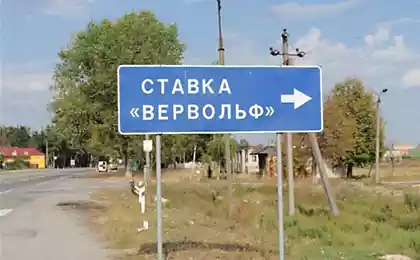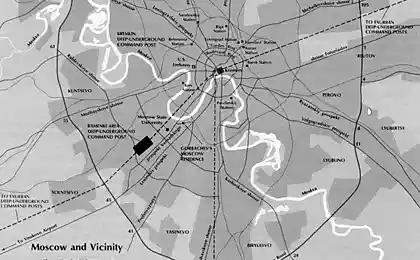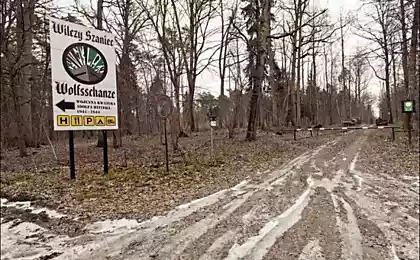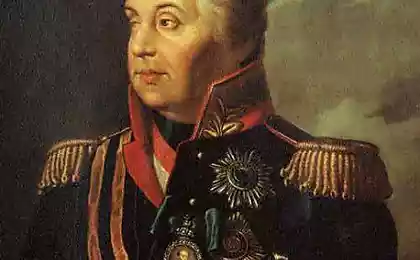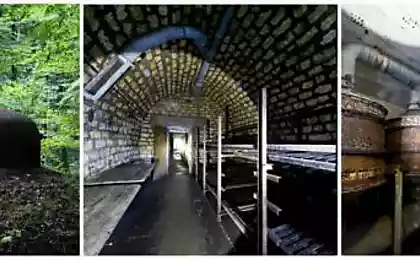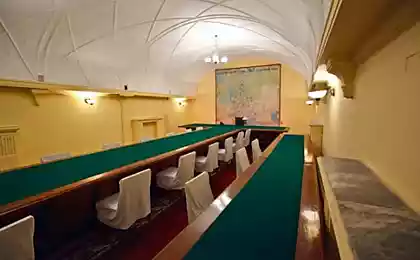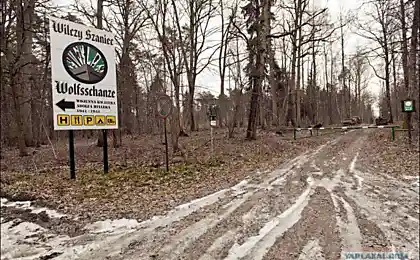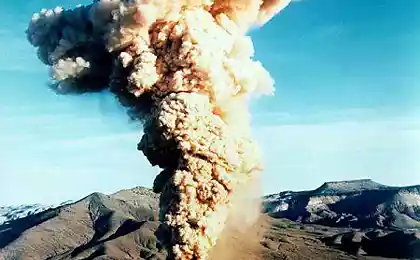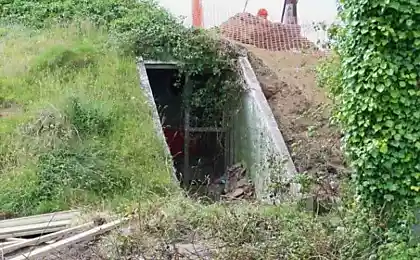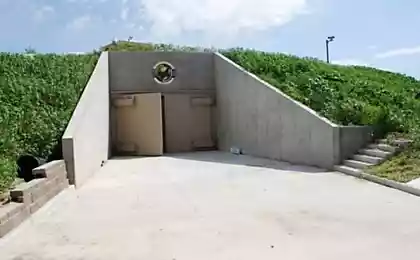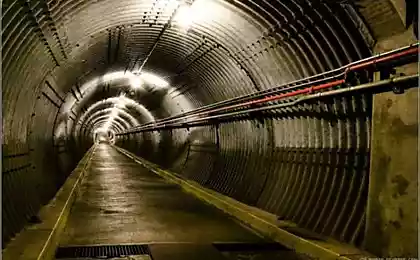1574
Underground bunker
The Maginot Line - the French system of fortifications on the border with Germany from Belfort to Longiyona. The place which today is the story, it was the first ever scheduled in the list of planned to visit the facilities. driving 250 kilometers of Alsace and Lorraine, and get to the desired us to the forest, we park the car in a clearing near the highway, wear rubber boots and go to the target point ... That weekend we were not lucky with the weather: all the time, it was overcast and on the way we repeatedly passed through the dense rain bands. Coming out of the car, it became clear that without rubber boots then you can not survive - a primer leading into the forest has been blurred and represented a mess, which is very accurately conveys the picture. Taking a whole multikilogram ammunition, we hit the road for this primer.

Dirt road going uphill all the time, and a kilometer rests on the fork: one path goes to the left - the second to the right, and a small overgrown path goes straight. We go to the right, as this way closer to the coveted point on the screen navigator. Soon this track has to collapse and go straight through the forest, since he is not much overgrown with bushes, so much discomfort from the movement on the terrain there, straining a constant slope, as behind a dozen kilograms of ammunition each time to climb the hill little tiring. As a result, we come to the point marked in the Navigator, and ... nothing. Around all the same forest and not the slightest sign of the promised bunker.
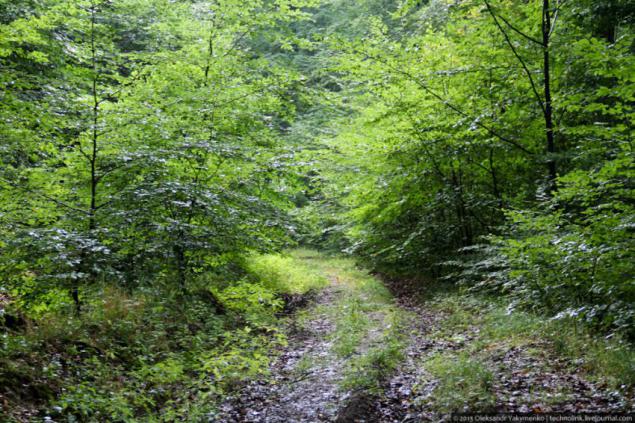
Explore the area in a radius of hundreds of meters from the point with the coordinates and found no trace of the bunker, go back to the fork and this time go straight at overgrown and, apparently, many years did not use primer. Primer rests in a clearing overgrown with tall grass and shrubs on the belt. For forest clearing continues, but the sense to go there, I do not see. Bypassing all in a radius of hundreds of meters, and finding nothing, we return back to the fork. In addition to the navigator at me with a printout with Google Maps, I bring it below. Green arrows show the coordinates of the bunker where he would have to be marked with a red dot I place parking our car. As it turned out the location of the primers in the woods with Google release cards do not correspond to reality and soon we were convinced. What to do? We decide to go to the last unexplored path at the fork - the left as it became apparent that the hopper can be anywhere in the forest.

Go left, spend an hour and a lot of effort to search for the bunker, shares with his brother for more girth area and walk a few hundred meters from each other, lost sight of the shouting, in order not to get lost. It would like to have the least in this situation. We both start to see hallucinations me every tree trunk away imagining coveted gray concrete, a brother sees bronekupola everywhere, but it's all an illusion. Several times I vospryanuv spirit, chasing a gray spot in hundreds of meters behind the bushes, but turned out to be a regular spot tree trunk. As a result, it becomes obvious that we are simply wasting our strength: with the same success can be to scour the woods until morning. Wet with sweat due to hour and a half walk along the forest hills with a complete outfit, back in the car. Fortunately I have the coordinates previously stored in the Navigator.
In the car I have is a tablet, but it saved the German diggers story about how they visited the place. Coordinates of his I took with their own stories, so they were sure. I re-read the story again, but I do not find anything new in it: they are the same as we have come to the coordinates and also saw around a forest. Then split and have been searching for the bunker in the woods, but in the end found him. The fact is that after this bunker we had planned one very massive object kilometers of underground passages and six warheads, each of which rise hundreds of steps. That is wasting time searching for a small military refuge in the forest it would be foolish, if not one "but." This shelter is a striking historical artifact 1940, I wanted to see with my own eyes. For his sake I have included a small refuge in the route bunkertura and give up at the finish line as the second did not want to. It was decided to make the last search run, following in the footsteps of the Germans, described in their history. Taking a tablet, we set off on the same road to the fork. The only place we have not been investigated - the forest for clearing and we went to the meadow straight ahead. In the description of the Germans figured word «Lichtung» and it played a key role as the other landmarks in their description of the way no more. Translation I did not know, but on the plate I had a dictionary that the word translated as "clearing, clearing, clearing (in the forest)." It became clear that we are on the right track. Description of the way the Germans ended up this way: "We have decided to bypass the clearing, which was not in our plan, and try to look for it. Going round the meadow and a few wandering through the woods, we came across a barbed wire - it meant that the bunker there, and soon we noticed bronekupol. It was him. "The description is not very clear, but at least the search direction was clear. It was decided: go through the clearing, split and go in different directions, five minutes back to the collection point, and if no one is found, go back to the car, relax and move to the main point of today's route. Spending power before a huge object that was waiting for us tonight, but it was impossible to derogate from the purpose it was very sad, especially when it was so close.

So we split up and went in search of each to his own. A hundred meters after passing through the woods, I saw him.
It's hard to put into words my feelings. Probably something like Columbus felt when he saw the land, after a month at sea. I was happy, and he called his brother cry of joy: "Found it! I found the bunker! ". But the brother had gone so far that my cry came before him at once. When we met, they were both joyful and cheerful. After all, we have already begun to avoid a bitter thought that prolazit two hours this forest will have to leave with nothing. And then suddenly, our search was rewarded.
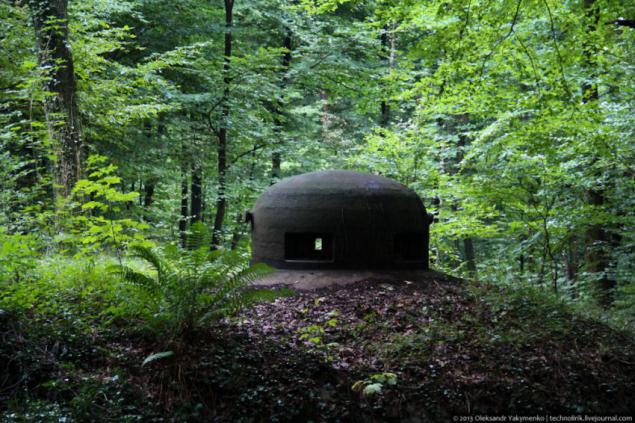
But the bunker was locked. The photo shows the door locked and no bridge over the moat diamantovy.
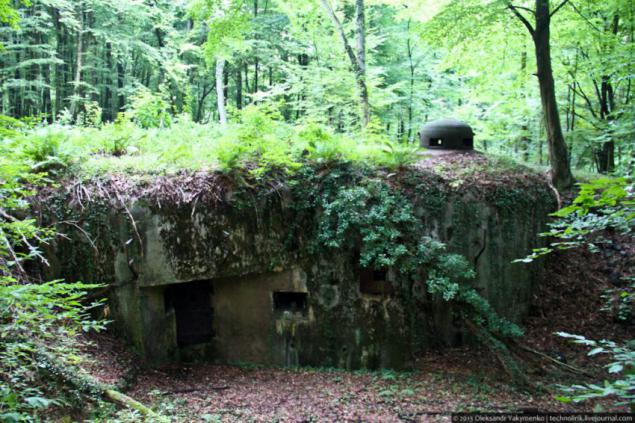
But I'm not angry at all. It just means that we have reached one of the two entrances to the underground shelter. The second input should be within a radius of no more than two hundred meters from the first. We again split up and went in search in different directions, but after going a hundred meters, I found a second entrance to the shelter. Again he shouted to his brother that he was to me.
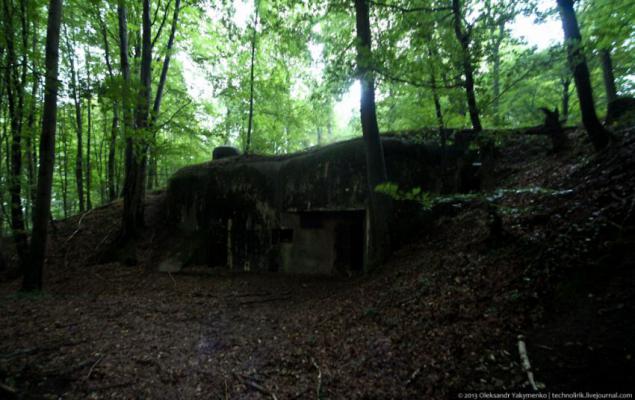
And only came closer and saw the open door welcoming and self-made bridge from branches across the moat diamantovy, we finally realized that now nothing will prevent us to penetrate into the underworld. Entrance to the shelter we found just in time: the storm began, and the minute rain intensified. When we went inside, the outside has thunder and pouring in buckets.
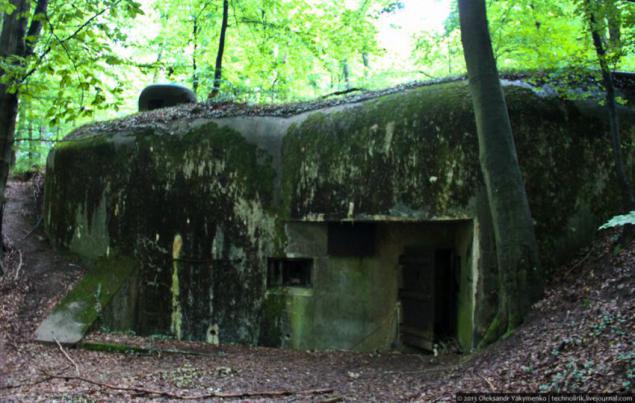
We took out the lights and begin to explore this lost world. In the photo the entrance to the shelter. On the right door to the street through which we entered. Preserved lantern at the entrance and electrical wiring to it.
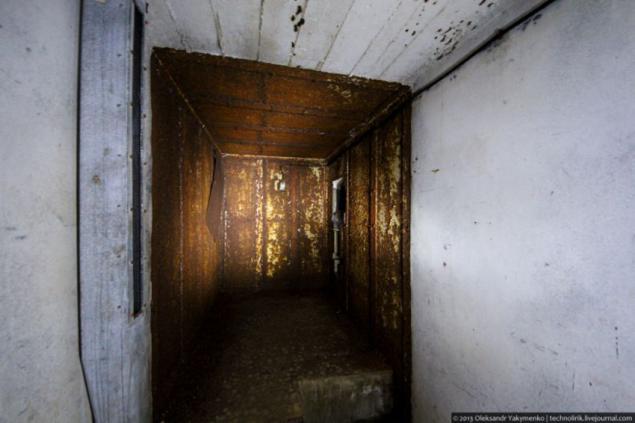
The input block is equipped with two bronekupolami to monitor the area and firing in the event of an approaching enemy. Both bronekupola in excellent condition, only rust issues of abandonment.
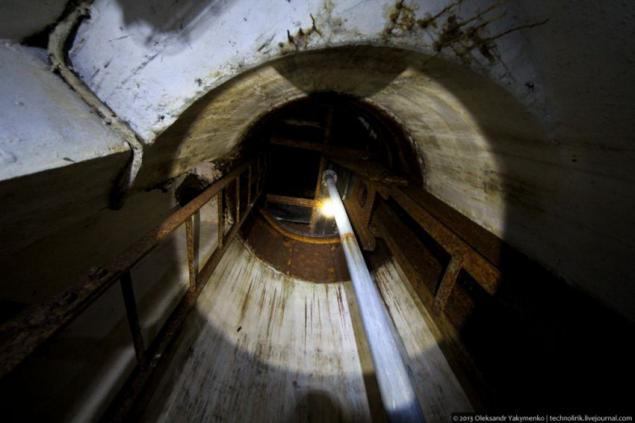
In this photo you can even see the site in bronekupola dipped hoist down for loading arms and ammunition, and then also rises. With the help of counterweights ascent and descent carried out by one person in a purely mechanical. I was in such bronekupole in another abandoned bunker and there is the system fully worked. I am sure that it works here, judging by the fact that the chain is lubricated. Did not check.

At the entrance to the wall a small message in French: & quot; «I beg you to accept, Sir, the assurances of my complete respect.»
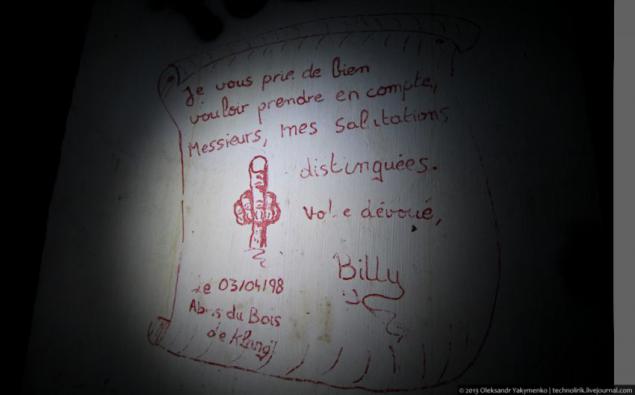
Before we go down to the shelter itself, tell us briefly what this object is and why it was built. In French facilities of this kind are called Abri and designed to accommodate the personnel of the army. Such shelters were built along the Maginot Line forts between combat and is of two kinds. The first type - Abri Surface. Vault this type placed on the ground surface or in the immediate vicinity of the surface, and are made up of an elongated meter unit 70 with two inputs. Asylum of this type will be my next post. We found in the woods bunker belongs to the shelters of the second type, the so-called Abri Caverne. The plan of this refuge is presented in the figure below.
The shelter consists of a barracks designed to house a few hundred soldiers. Barrack lies under the ground at a depth of 20 to 25m, and connects with the outside through two input units arranged on the surface (in the figure denote partial squares). Each input block except bronekupola and loopholes with machine gun, was also filter-ventilation system. and post the guard on duty. The plan marked:
C: kitchen;
Cl: bronekupol GFM type A;
ST: barracks for the accommodation of staff;
CO: room officer, Commander-seekers;
E: input;
FM: loophole for hand guns 7, 5mm Mdle 1924/29;
I: tunnel wastewater and sewage in the same location was an emergency exit;
M: the engine room with the engine for emergency shelter supplies electricity;
R: water tanks;
I note that this plan is not an exact plan of the refuge. Though they all had a similar device, but differ in the details, size and location of the rooms. For example, in this respect, you see two longitudinal inspection gallery (underground passages), as in our shelter were three and the number of rooms for the accommodation of staff was two times more than on this plane. But the point is, I think, is clear. Now let's see how it all looks.
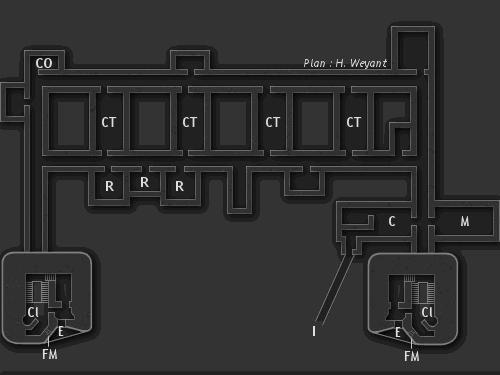
Stairs down. How sadly, but the asshole cylinders with paint and got here, leaving the recent products of his mind and hand curves on the walls. Although due to the inaccessibility of this shelter is still slightly affected by the invasion Gopnik with paint. Many others abandoned construction of the Maginot Line and izrisoval scribbled up and down. In the upper part of the photo are the ruins of the lifting mechanism, by which the lower level fell boxes provisions and ammunition. You can also see a beautifully preserved vent pipe coming from the filter ventilation of the room on the lower level of the barracks.

The mechanism of the lifting device, with the top photo, too, well preserved, but the cable is not

Going down the stairs to fly below into the filter-ventilation room excellent state of preservation. In the right part of the photo is visible lights, which survived even the ceiling, which is not often found. Wiring, too, all in place. Surprisingly!
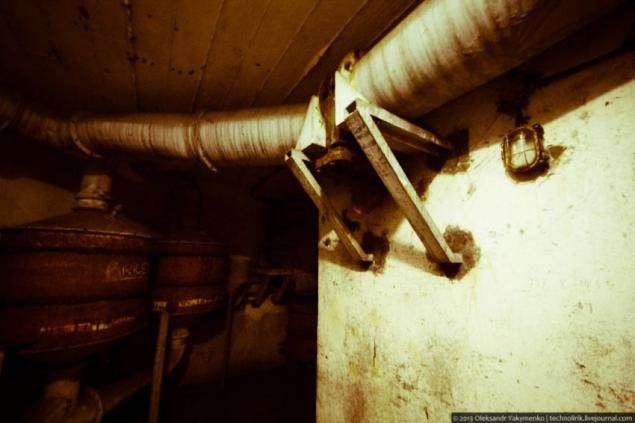
Filter-ventilation unit in excellent condition, only filters corroded by rust. The French were afraid that the Germans during the war, a new use deadly gas as it did in the First World, and therefore every object of the Maginot Line, from the simple to the polukaponira huge fort was equipped with a filter system. Each filter can work during the day, then had to be replaced by a new, so in many sites of the Maginot Line in addition to the set of filters you can also find a certain amount of spare filters. Filters activated only in the case of a gas attack, the rest of the ventilation air intake is usually carried out from the surface, avoiding the HLF.

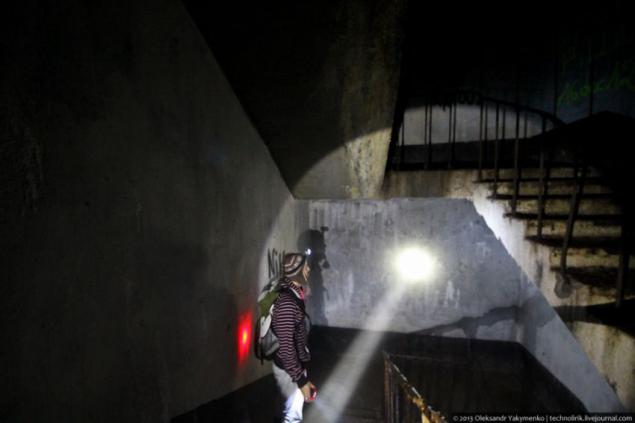
View from the bottom up, we can estimate the depth of the refuge.
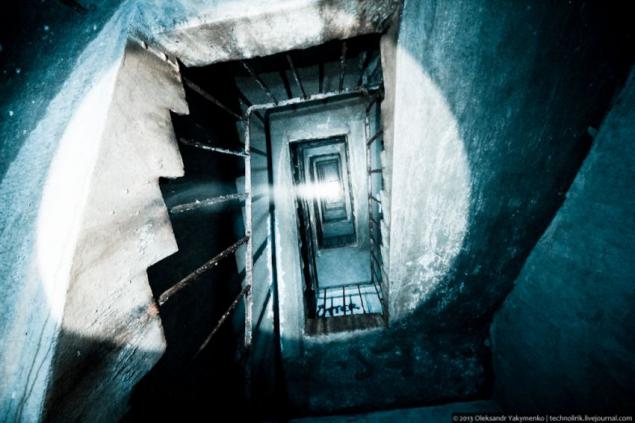
The input unit we looked completely down to the lower level in barracks.
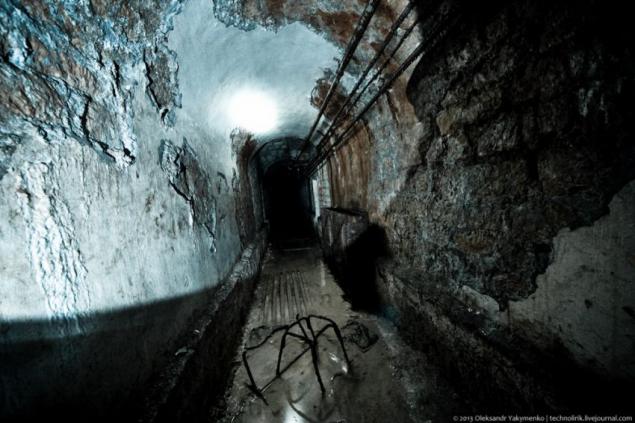
The first surprise met us as soon as the last step ladder - water. This part of the refuge flooded with water. What surprised - the water from somewhere took a thick layer of either sand, or other light-colored viscous soil. It felt like going to the beach: clean, clear water lapped, beneath the sand. It lacked only the electric sun to fully simulate the underground spa.

Those who were here before us have built a track of different items, which you can reach the dry part of the underground barracks are not soaking the feet, legs if ordinary shoes. It is possible to estimate the length of one of the three parallel Poterna - about 200 meters.
A look back - we came out. Visible arrayed skeletons of chairs, which made their way into the hopper of those who came without rubber boots.
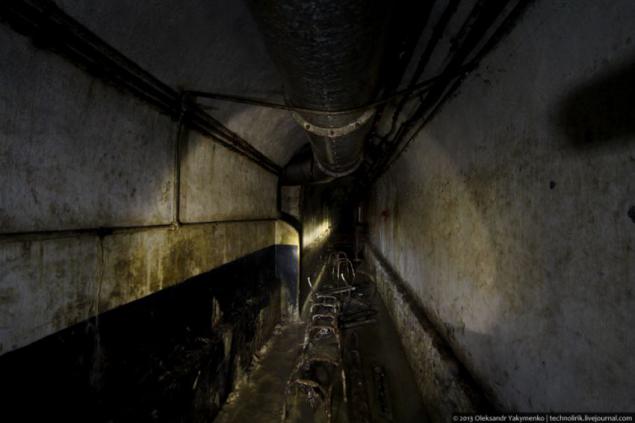
Let's start the review themselves directly barracks. Again, we were met by cleanliness and perfectly preserved. It is due to the fact that this shelter is not so easy to find and it is located in a relatively remote from towns and villages, it is not subjected to this invasion of the Vandals and tsvetmetchikov, as happened with almost all other abandoned sites that I have visited before.
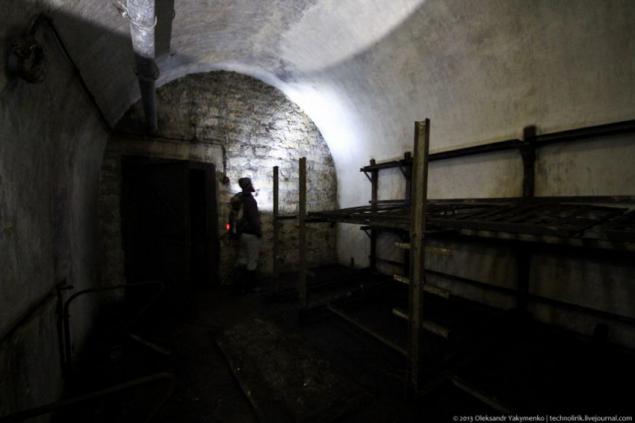
Someone visited the shelter in the past, then I leave their pictures - in this case drawn in chalk symbol of the Maginot Line.

Go ahead along the main inspection gallery.
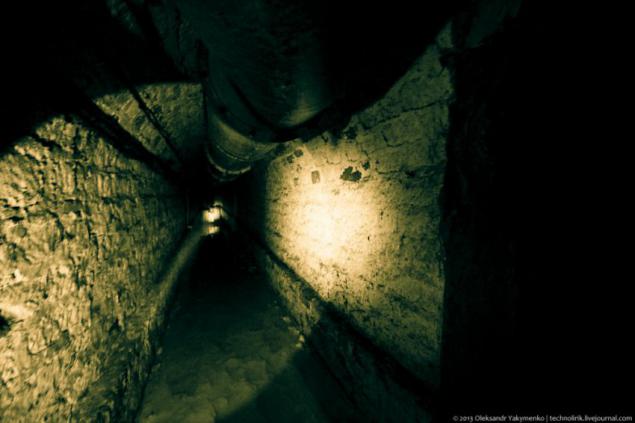
Once again, the barracks with beds and tables preserved. Surprised bricklaying asylum. Many objects lines were either concrete or masonry was plastered outside. It's just a wall left as they are. Perhaps because of the traditional lack of funds during construction.
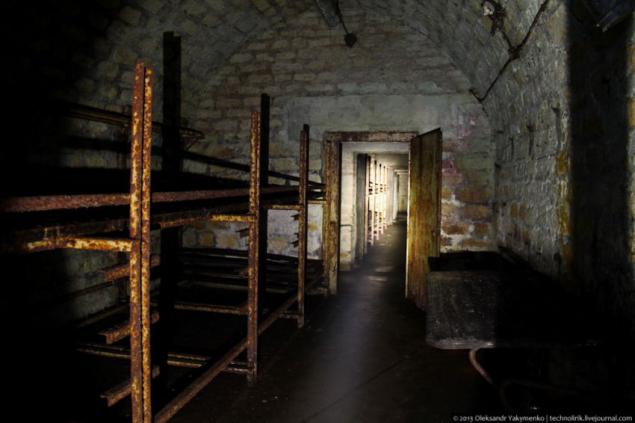
Room amazing state of preservation. In fact, since the early 30s, when it was built the shelter, the room remained completely original: the soldiers' beds, tables, ventilation, wiring - all completely in place. Not enough just to bed mattresses and bedding. Everything else looks the same as it looked during the operation of asylum. Only in order to touch the history so close should make their way to 250 km and two hours to wander through the woods. But the interesting thing was waiting for us ahead ...
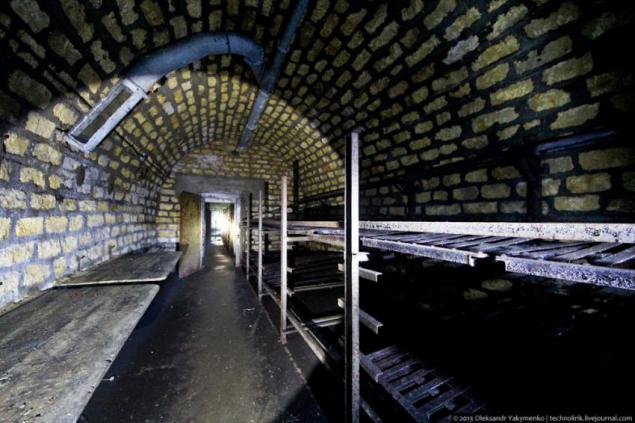
Leaving the barracks and go further along the inspection gallery, looking into all the rooms. As seen on the pictures of the shelter is already dry. The photo box of sand, whose purpose - to block the ground water in case of its penetration into the shelter.
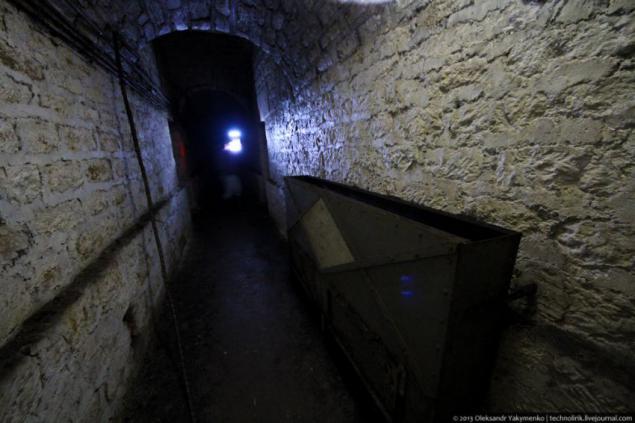
The room where the soldiers could wash, freshen up and wash form. The hot water in the refuge was not only cold. Shower room we have not been detected, then it probably was not there.

The room is not set destination. Surprised poshtukaturennymi walls and preserved the glove locker.


And this is the kitchen from which there is very little: a rusted boiler to heat water and extract, which is difficult to see in the photo, but it is in the upper right corner.
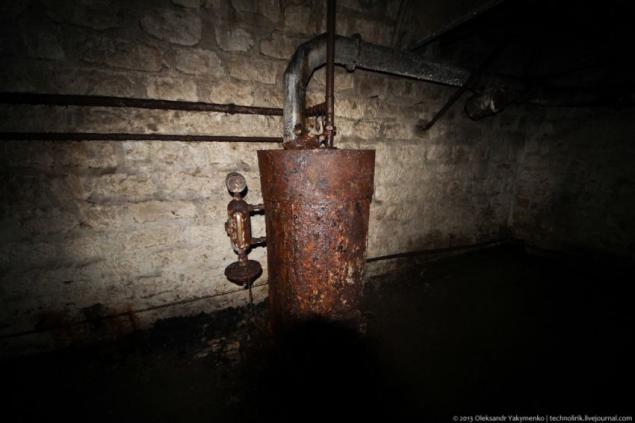
Much better preserved area with water tanks. In general, water tanks - that is stored in each of the abandoned object, regardless of its degree of razvandalennosti and razvorovannosti. The reason is simple - it is impossible to steal them.
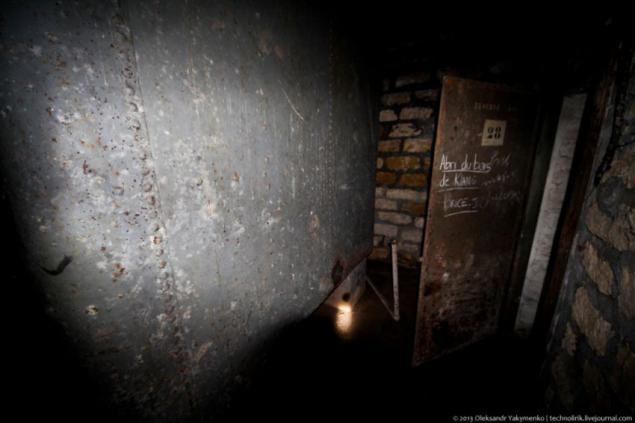
Photograph the room is very difficult as the two huge tanks occupy the space of the room completely, leaving only a narrow passage near the very walls. There is also the well and the pump through which the injection of water into reservoirs.
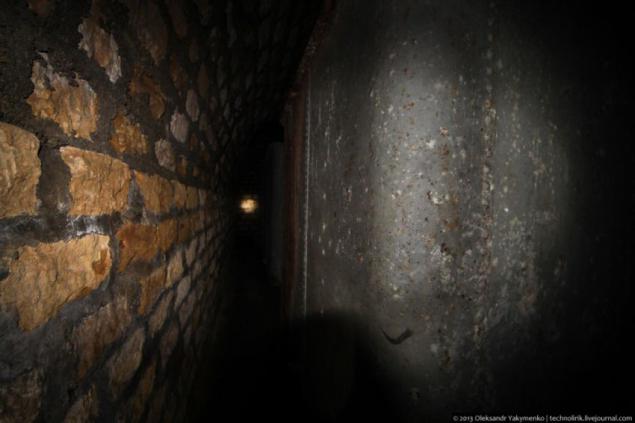
And this is the engine room with the generator set. Power seekers carried out externally via an underground cable, but in the case of military action could be damaged cable - in this case has been provided a backup diesel generator that produces electricity solely for lighting and ventilation asylum. Under the ceiling visible pipe supplying air to the diesel engine and exhaust system.

The diesel engine is very small - only one cylinder. In the corner of the room kept fuel tanks and the floor is filled with a mixture of water, machine oil and dirt. Near the remains of the motor can be seen on the floor of the generator stator. The photos of this place made in the early 2000s, the generator is still intact in its place. I do not understand what motivates people to overcome this path to go down to the dungeon and durable steel hollow generator to get out of a bundle of copper, the price of which four euros per kilogram. How much effort must be expended to get the ridiculous four to five euros! Petrol will cost more than the profit from such fishing. But in every country there are morons, even if it is a rich and prosperous France.
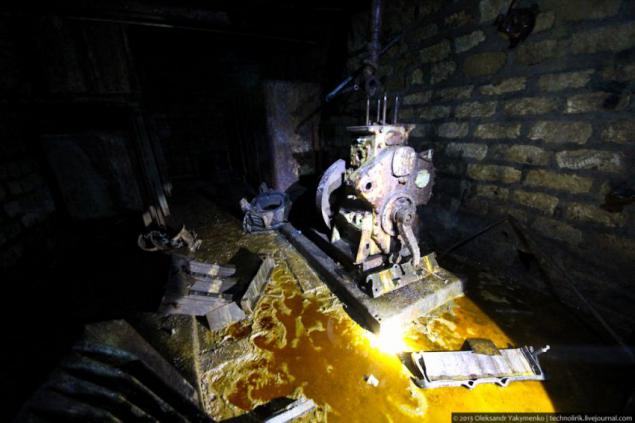
In the next room were found drums with some strange chemical substance. Most likely in barrels bleach for disinfection, deodorization and how protivoipritny degasser, in the case of the Germans gases.
And now the most interesting - actually something for which we came here. What you see in this picture - the main feature of this shelter and vivid historical artifact 1939 - 1940 period.

Dirt road going uphill all the time, and a kilometer rests on the fork: one path goes to the left - the second to the right, and a small overgrown path goes straight. We go to the right, as this way closer to the coveted point on the screen navigator. Soon this track has to collapse and go straight through the forest, since he is not much overgrown with bushes, so much discomfort from the movement on the terrain there, straining a constant slope, as behind a dozen kilograms of ammunition each time to climb the hill little tiring. As a result, we come to the point marked in the Navigator, and ... nothing. Around all the same forest and not the slightest sign of the promised bunker.

Explore the area in a radius of hundreds of meters from the point with the coordinates and found no trace of the bunker, go back to the fork and this time go straight at overgrown and, apparently, many years did not use primer. Primer rests in a clearing overgrown with tall grass and shrubs on the belt. For forest clearing continues, but the sense to go there, I do not see. Bypassing all in a radius of hundreds of meters, and finding nothing, we return back to the fork. In addition to the navigator at me with a printout with Google Maps, I bring it below. Green arrows show the coordinates of the bunker where he would have to be marked with a red dot I place parking our car. As it turned out the location of the primers in the woods with Google release cards do not correspond to reality and soon we were convinced. What to do? We decide to go to the last unexplored path at the fork - the left as it became apparent that the hopper can be anywhere in the forest.

Go left, spend an hour and a lot of effort to search for the bunker, shares with his brother for more girth area and walk a few hundred meters from each other, lost sight of the shouting, in order not to get lost. It would like to have the least in this situation. We both start to see hallucinations me every tree trunk away imagining coveted gray concrete, a brother sees bronekupola everywhere, but it's all an illusion. Several times I vospryanuv spirit, chasing a gray spot in hundreds of meters behind the bushes, but turned out to be a regular spot tree trunk. As a result, it becomes obvious that we are simply wasting our strength: with the same success can be to scour the woods until morning. Wet with sweat due to hour and a half walk along the forest hills with a complete outfit, back in the car. Fortunately I have the coordinates previously stored in the Navigator.
In the car I have is a tablet, but it saved the German diggers story about how they visited the place. Coordinates of his I took with their own stories, so they were sure. I re-read the story again, but I do not find anything new in it: they are the same as we have come to the coordinates and also saw around a forest. Then split and have been searching for the bunker in the woods, but in the end found him. The fact is that after this bunker we had planned one very massive object kilometers of underground passages and six warheads, each of which rise hundreds of steps. That is wasting time searching for a small military refuge in the forest it would be foolish, if not one "but." This shelter is a striking historical artifact 1940, I wanted to see with my own eyes. For his sake I have included a small refuge in the route bunkertura and give up at the finish line as the second did not want to. It was decided to make the last search run, following in the footsteps of the Germans, described in their history. Taking a tablet, we set off on the same road to the fork. The only place we have not been investigated - the forest for clearing and we went to the meadow straight ahead. In the description of the Germans figured word «Lichtung» and it played a key role as the other landmarks in their description of the way no more. Translation I did not know, but on the plate I had a dictionary that the word translated as "clearing, clearing, clearing (in the forest)." It became clear that we are on the right track. Description of the way the Germans ended up this way: "We have decided to bypass the clearing, which was not in our plan, and try to look for it. Going round the meadow and a few wandering through the woods, we came across a barbed wire - it meant that the bunker there, and soon we noticed bronekupol. It was him. "The description is not very clear, but at least the search direction was clear. It was decided: go through the clearing, split and go in different directions, five minutes back to the collection point, and if no one is found, go back to the car, relax and move to the main point of today's route. Spending power before a huge object that was waiting for us tonight, but it was impossible to derogate from the purpose it was very sad, especially when it was so close.

So we split up and went in search of each to his own. A hundred meters after passing through the woods, I saw him.
It's hard to put into words my feelings. Probably something like Columbus felt when he saw the land, after a month at sea. I was happy, and he called his brother cry of joy: "Found it! I found the bunker! ". But the brother had gone so far that my cry came before him at once. When we met, they were both joyful and cheerful. After all, we have already begun to avoid a bitter thought that prolazit two hours this forest will have to leave with nothing. And then suddenly, our search was rewarded.

But the bunker was locked. The photo shows the door locked and no bridge over the moat diamantovy.

But I'm not angry at all. It just means that we have reached one of the two entrances to the underground shelter. The second input should be within a radius of no more than two hundred meters from the first. We again split up and went in search in different directions, but after going a hundred meters, I found a second entrance to the shelter. Again he shouted to his brother that he was to me.

And only came closer and saw the open door welcoming and self-made bridge from branches across the moat diamantovy, we finally realized that now nothing will prevent us to penetrate into the underworld. Entrance to the shelter we found just in time: the storm began, and the minute rain intensified. When we went inside, the outside has thunder and pouring in buckets.

We took out the lights and begin to explore this lost world. In the photo the entrance to the shelter. On the right door to the street through which we entered. Preserved lantern at the entrance and electrical wiring to it.

The input block is equipped with two bronekupolami to monitor the area and firing in the event of an approaching enemy. Both bronekupola in excellent condition, only rust issues of abandonment.

In this photo you can even see the site in bronekupola dipped hoist down for loading arms and ammunition, and then also rises. With the help of counterweights ascent and descent carried out by one person in a purely mechanical. I was in such bronekupole in another abandoned bunker and there is the system fully worked. I am sure that it works here, judging by the fact that the chain is lubricated. Did not check.

At the entrance to the wall a small message in French: & quot; «I beg you to accept, Sir, the assurances of my complete respect.»

Before we go down to the shelter itself, tell us briefly what this object is and why it was built. In French facilities of this kind are called Abri and designed to accommodate the personnel of the army. Such shelters were built along the Maginot Line forts between combat and is of two kinds. The first type - Abri Surface. Vault this type placed on the ground surface or in the immediate vicinity of the surface, and are made up of an elongated meter unit 70 with two inputs. Asylum of this type will be my next post. We found in the woods bunker belongs to the shelters of the second type, the so-called Abri Caverne. The plan of this refuge is presented in the figure below.
The shelter consists of a barracks designed to house a few hundred soldiers. Barrack lies under the ground at a depth of 20 to 25m, and connects with the outside through two input units arranged on the surface (in the figure denote partial squares). Each input block except bronekupola and loopholes with machine gun, was also filter-ventilation system. and post the guard on duty. The plan marked:
C: kitchen;
Cl: bronekupol GFM type A;
ST: barracks for the accommodation of staff;
CO: room officer, Commander-seekers;
E: input;
FM: loophole for hand guns 7, 5mm Mdle 1924/29;
I: tunnel wastewater and sewage in the same location was an emergency exit;
M: the engine room with the engine for emergency shelter supplies electricity;
R: water tanks;
I note that this plan is not an exact plan of the refuge. Though they all had a similar device, but differ in the details, size and location of the rooms. For example, in this respect, you see two longitudinal inspection gallery (underground passages), as in our shelter were three and the number of rooms for the accommodation of staff was two times more than on this plane. But the point is, I think, is clear. Now let's see how it all looks.

Stairs down. How sadly, but the asshole cylinders with paint and got here, leaving the recent products of his mind and hand curves on the walls. Although due to the inaccessibility of this shelter is still slightly affected by the invasion Gopnik with paint. Many others abandoned construction of the Maginot Line and izrisoval scribbled up and down. In the upper part of the photo are the ruins of the lifting mechanism, by which the lower level fell boxes provisions and ammunition. You can also see a beautifully preserved vent pipe coming from the filter ventilation of the room on the lower level of the barracks.

The mechanism of the lifting device, with the top photo, too, well preserved, but the cable is not

Going down the stairs to fly below into the filter-ventilation room excellent state of preservation. In the right part of the photo is visible lights, which survived even the ceiling, which is not often found. Wiring, too, all in place. Surprisingly!

Filter-ventilation unit in excellent condition, only filters corroded by rust. The French were afraid that the Germans during the war, a new use deadly gas as it did in the First World, and therefore every object of the Maginot Line, from the simple to the polukaponira huge fort was equipped with a filter system. Each filter can work during the day, then had to be replaced by a new, so in many sites of the Maginot Line in addition to the set of filters you can also find a certain amount of spare filters. Filters activated only in the case of a gas attack, the rest of the ventilation air intake is usually carried out from the surface, avoiding the HLF.


View from the bottom up, we can estimate the depth of the refuge.

The input unit we looked completely down to the lower level in barracks.

The first surprise met us as soon as the last step ladder - water. This part of the refuge flooded with water. What surprised - the water from somewhere took a thick layer of either sand, or other light-colored viscous soil. It felt like going to the beach: clean, clear water lapped, beneath the sand. It lacked only the electric sun to fully simulate the underground spa.

Those who were here before us have built a track of different items, which you can reach the dry part of the underground barracks are not soaking the feet, legs if ordinary shoes. It is possible to estimate the length of one of the three parallel Poterna - about 200 meters.
A look back - we came out. Visible arrayed skeletons of chairs, which made their way into the hopper of those who came without rubber boots.

Let's start the review themselves directly barracks. Again, we were met by cleanliness and perfectly preserved. It is due to the fact that this shelter is not so easy to find and it is located in a relatively remote from towns and villages, it is not subjected to this invasion of the Vandals and tsvetmetchikov, as happened with almost all other abandoned sites that I have visited before.

Someone visited the shelter in the past, then I leave their pictures - in this case drawn in chalk symbol of the Maginot Line.

Go ahead along the main inspection gallery.

Once again, the barracks with beds and tables preserved. Surprised bricklaying asylum. Many objects lines were either concrete or masonry was plastered outside. It's just a wall left as they are. Perhaps because of the traditional lack of funds during construction.

Room amazing state of preservation. In fact, since the early 30s, when it was built the shelter, the room remained completely original: the soldiers' beds, tables, ventilation, wiring - all completely in place. Not enough just to bed mattresses and bedding. Everything else looks the same as it looked during the operation of asylum. Only in order to touch the history so close should make their way to 250 km and two hours to wander through the woods. But the interesting thing was waiting for us ahead ...

Leaving the barracks and go further along the inspection gallery, looking into all the rooms. As seen on the pictures of the shelter is already dry. The photo box of sand, whose purpose - to block the ground water in case of its penetration into the shelter.

The room where the soldiers could wash, freshen up and wash form. The hot water in the refuge was not only cold. Shower room we have not been detected, then it probably was not there.

The room is not set destination. Surprised poshtukaturennymi walls and preserved the glove locker.


And this is the kitchen from which there is very little: a rusted boiler to heat water and extract, which is difficult to see in the photo, but it is in the upper right corner.

Much better preserved area with water tanks. In general, water tanks - that is stored in each of the abandoned object, regardless of its degree of razvandalennosti and razvorovannosti. The reason is simple - it is impossible to steal them.

Photograph the room is very difficult as the two huge tanks occupy the space of the room completely, leaving only a narrow passage near the very walls. There is also the well and the pump through which the injection of water into reservoirs.

And this is the engine room with the generator set. Power seekers carried out externally via an underground cable, but in the case of military action could be damaged cable - in this case has been provided a backup diesel generator that produces electricity solely for lighting and ventilation asylum. Under the ceiling visible pipe supplying air to the diesel engine and exhaust system.

The diesel engine is very small - only one cylinder. In the corner of the room kept fuel tanks and the floor is filled with a mixture of water, machine oil and dirt. Near the remains of the motor can be seen on the floor of the generator stator. The photos of this place made in the early 2000s, the generator is still intact in its place. I do not understand what motivates people to overcome this path to go down to the dungeon and durable steel hollow generator to get out of a bundle of copper, the price of which four euros per kilogram. How much effort must be expended to get the ridiculous four to five euros! Petrol will cost more than the profit from such fishing. But in every country there are morons, even if it is a rich and prosperous France.

In the next room were found drums with some strange chemical substance. Most likely in barrels bleach for disinfection, deodorization and how protivoipritny degasser, in the case of the Germans gases.
And now the most interesting - actually something for which we came here. What you see in this picture - the main feature of this shelter and vivid historical artifact 1939 - 1940 period.
